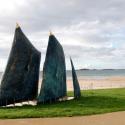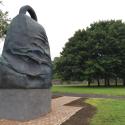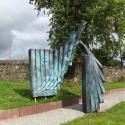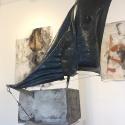Discipline
Architectural / Monumental / Relief
Figurative / Realism
Installation
Material
Bronze
Metal (other)
Steel
Region
Northern Ireland
Biography
Since 1997 Holger Lonze has worked as a professional sculptor on more than 25 public commissions in bronze and steel, ranging from €5k to €120k, as well as artist-in-residence for several councils and organisations. With a background in architecture, he is concerned with location-specific work that responds to its environment and users while contextual research into local archaeology, history, and folk life informs the concepts of the work. A passion for maritime traditions, folklore, and the Irish language results in a poetic response to the rich culture, and landscape of the European Atlantic seaboard, often informed by journeys in self-made canvas boats, the iconic curachs of Ireland. Modern fabrication technology is complemented by experimental archaeology practice, including low-carbon Bronze Age metal casting with charcoal pit furnaces and clay moulds and the use of regenerative and recycled materials, an approach that brings local archaeology alive and allows communities to participate in the creative process, offering a unique contemporary approach with a deeply sustainable ethos. Working across the spectrum of monumental work and small-scale sculpture, Holger invites close interaction between the beholder and his tactile work. Poetry of form, readability on various levels, and a sense of timelessness with relevance to our time are concerns to create work that is contemporary and raw yet exhibiting an intrinsic element of grace and otherworldliness.
The human condition of being confined to land yet drawn by sea, has been a central theme for Holger’s work the past decade. The visual vocabulary of his poetic objects are deeply rooted in ancient and present maritime culture: waves, ocean surfaces, traditional boats, sails, birds, intermodal shipping containers, bells, and mythological protagonists. Forms are combined to create a unique visual language that is founded in realism, yet becoming more abstract: individual forms intersect and penetrate each other, man becomes bird, ocean waves occupy the surface of bells, shipping containers, and sails. The unique physical conundrum that only in sculpture two or more forms can occupy the same Cartesian space at the same moment of time, is a unique characteristic of his visual language: the combination of natural form creates new sculptural, abstract form.



